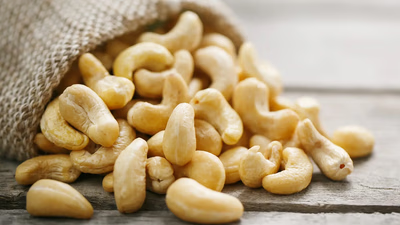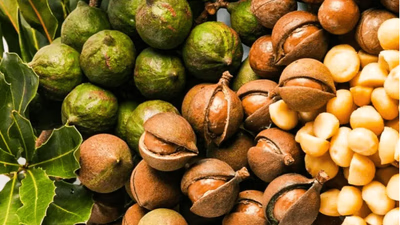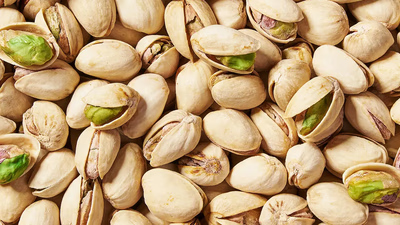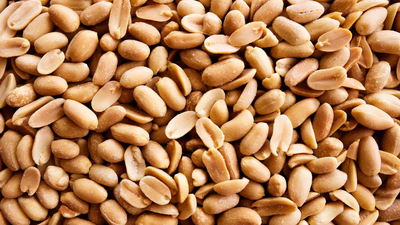
Peanut export opportunities in Middle East trade platforms.
The United States is a large market for peanut products. High consumption, variety of products and stable demand in this country make it an attractive market for peanut exports. China, with its high population and significant economic boom, is a large market for peanuts and other nut products. The increase in Chinese people's interest in healthy products and high nutritional properties has strengthened the peanut sales market in this country.
Countries like Germany, France, United Kingdom and Netherlands in Europe are important markets for the export of peanuts. Europe is considered as a market with a high demand for dried fruit products and a desire to consume natural and healthy products. The Canadian market is also one of the popular destinations for peanut exports. The high demand has created health conscious consumers and desire to consume natural products in this country.
Countries like Saudi Arabia, United Arab Emirates and Qatar are strong markets for dried fruit and peanut products. The increase in demand in this region due to population growth, changes in consumption patterns and the need for quality snacks has provided an export market in the Middle East . Countries such as Japan, South Korea, Australia and New Zealand are also significant markets for peanut exports. These areas are known as popular and interested markets for dried fruit products.
Before any import or export, research the target markets well. It is important to understand the demand, competitors, rules and regulations, distribution practices and business culture of those markets. Ensure that your products meet relevant quality, health and safety requirements using international standards and criteria. This includes international standards such as ISO and HACCP.
Make sure you have all the necessary permits and licenses to import and export peanuts. This includes import permits, sanitary and phytosanitary certificates, and other permits related to destination countries. Proper packaging and labeling are very important. Usually, each country applies its own rules and regulations for product packaging and labeling. Pay attention to this and make sure that the packaging and labeling of your products is compatible with the relevant requirements.
Make sure to choose the right shipping method for your products and use adequate insurance for your shipments. Pay attention to the instructions and prohibited items in international shipping. Before pricing your products in your target markets, research the competition and factor in manufacturing, shipping, insurance, and other costs. Also, check pricing trends in target markets.
Establishing and maintaining strong and reliable business relationships with suppliers, distributors, customers and relevant authorities in the peanut industry is very important. Establishing effective and reliable relationships with these people and organizations can be influential in your success in importing and exporting peanuts. There are always risks in exporting and importing. It is very important to review and manage these risks, including exchange rate changes, transportation problems, local laws and regulations, etc. Proper planning and use of risk management tools can help you to be more successful in exporting and importing.
Consider marketing and advertising strategies to attract new customers and increase awareness of your brand and products. Online marketing, attending trade shows and industry events, advertising in various media and using other methods to communicate with customers can help you grow your business. In a competitive market, ideas and innovation can help you stand out from the competition. Planning to develop new products, improve processes, and provide differentiated services can help you gain a competitive advantage.
China is the largest producer of peanuts in the world. Areas such as Shanxi, Henan, and Sichuan in China are known as peanut production hubs. India is also one of the largest producers of peanuts in the world. Regions like Andhra Pradesh, Karnataka, and Telangana in India are known as groundnut producing regions. Nigeria is one of the largest producers of peanuts in the African continent. Areas such as Kwando, Cotonou, and Kaduna in Nigeria are known as groundnut producing areas. Tanzania is also one of the largest producers of peanuts in the world. Areas such as Rwanda, Mbeya, and Shinde in Tanzania are known as groundnut producing areas. The United States is also one of the largest producers of peanuts in the world. Areas such as Georgia, North Carolina, and Alabama in the United States are known as peanut producing regions.
-

The cashew market in the Middle East is characterized by significant consumption and importation, particularly in countries like Iran, Saudi Arabia, the UAE, Qatar, and Oman. Cashews are favored for their taste and health benefits, making them a popular snack and ingredient in various dishes. Vietnam leads global production and export of cashews, followed by India and Brazil. The Middle East"s demand for cashews is driven by their versatility in cooking and snacking. While some countries like Iran and Oman cultivate cashews locally, they still rely heavily on imports to meet consumer needs. The region"s growing interest in healthy snacks further boosts the demand for cashews. Cashew nuts are not only consumed raw or roasted but also used in products like cashew cheese and mesma oil, enhancing their appeal across diverse culinary applications. The trade dynamics of cashews reflect broader trends in the Middle East"s food market, where health-conscious consumers seek nutritious options. "
-

Iran, Turkey, Syria, Lebanon, and Iraq are key almond producers in the Middle East, benefiting from favorable climates and fertile soils. These countries have developed almond production as a significant agricultural sector. West Asia is a major player in the global almond market, exporting raw almonds and processed products like almond oil and powder. The region"s almonds are integral to various industries, including food and cosmetics. With a growing domestic market, Asia is a significant consumer of almonds, particularly in China, the U. S. , Germany, India, and South Korea. The demand for healthy products has driven almond consumption in these countries.
The processing industry in West Asia has expanded to include diverse almond products used in snacks and sweets. As trade platforms evolve, verified exporters and importers play a crucial role in facilitating B2B transactions across the region. "
-

Australia dominates the global macadamia market, producing about 30% of the world"s supply. Other significant producers include South Africa, Hawaii, and California, all benefiting from favorable climatic conditions. Macadamia nuts are highly valued for their rich flavor and nutritional benefits, including healthy fats and vitamins. The demand for macadamia is rising in the food industry, particularly in health foods and snacks. In West Asia, countries like Iran and Saudi Arabia are major importers of macadamia nuts, utilizing them in various culinary applications. Despite challenges in cultivating macadamia in the Middle East due to water limitations, efforts are underway to establish plantations in Iran and Saudi Arabia. The economic significance of macadamia is underscored by its high market price and popularity among consumers. As a result, the trade of macadamia nuts is expected to grow further in these regions. "
-

Asia is a leading producer and exporter of various nuts, including almonds, hazelnuts, and walnuts. Countries like Iran, Turkey, China, and India dominate the market. The region"s diverse climate supports the cultivation of multiple nut varieties, making it a significant player in the global dried fruit industry. However, challenges such as climate change and water scarcity threaten production levels and quality. Farmers may need to adapt by cultivating drought-resistant plants to maintain yields. Economic growth in Asia has increased purchasing power, driving demand for nuts as snacks and cooking ingredients. The region"s robust export capabilities contribute to its profitability in international markets.
-

Iran dominates the global pistachio market, supplying over 70% of production and exporting primarily to China, the EU, India, Russia, and Saudi Arabia. The U. S. and Turkey also play significant roles in pistachio trade, with American and Turkish varieties being highly sought after for their quality. To successfully market pistachios internationally, businesses must identify target markets by researching demand and competition. Establishing a strong brand through effective marketing strategies is crucial. This includes creating appealing packaging and utilizing various advertising channels such as social media and trade shows. Quality assurance is vital; products must meet international standards regarding health and moisture content to stand out in competitive markets.
Building relationships with international traders through direct communication and networking is essential for success. Offering a diverse range of pistachio products can attract more buyers, while leveraging technology like e-commerce can enhance business operations. Price competitiveness is also key; understanding market pricing dynamics helps in setting attractive prices for products. Compliance with international regulations ensures smooth export processes. Major consumer markets include China, the U. S. , Germany, France, Italy, India, and Gulf countries like the UAE and Saudi Arabia where pistachios are popular for their taste and nutritional benefits.
-

The global peanut market presents significant opportunities for exporters, particularly in regions like the United States, China, and Europe. The U. S. is a major consumer of peanut products, driven by stable demand and a variety of offerings. China"s growing interest in healthy foods has bolstered its peanut market, while European countries such as Germany and the UK show high demand for natural products. The Middle East, including Saudi Arabia and the UAE, is emerging as a strong market due to population growth and changing consumption patterns. Successful import/export operations require thorough market research to understand demand, competition, regulations, and cultural practices. Compliance with international standards like ISO and HACCP is crucial for quality assurance.
Proper packaging and labeling must align with destination country regulations. Additionally, selecting appropriate shipping methods and managing risks related to exchange rates and transportation are essential for success. Building reliable relationships with suppliers and customers can enhance business prospects. Marketing strategies such as online advertising and participation in trade shows can help attract new clients. Innovation in product development can provide a competitive edge in this dynamic market. "
-

The demand for hazelnuts in Asia has surged due to rising health consciousness, with countries like China, India, Japan, and South Korea leading in consumption. Major producers such as Iran, Turkey, China, and Vietnam are enhancing their production capabilities to meet this growing demand. Effective marketing strategies, including quality management and direct customer engagement through social media, are crucial for success in this competitive market. Exporters should also focus on developing processed hazelnut products like chopped nuts and hazelnut oil to increase their market appeal. Understanding local tastes is essential for tailoring products to specific regional preferences. The hazelnut market is not only a significant consumer base but also a vital export sector within Asia"s dried fruit industry. "
-

Iran, Turkey, Azerbaijan, Armenia, and Iraq are key walnut producers in West Asia, with ideal conditions for cultivation. Establishing an online platform for walnut exports is crucial for reaching international customers. A well-optimized website should feature detailed product information, high-quality images, and secure payment options. Effective SEO strategies include using relevant keywords and creating valuable content to enhance search engine rankings. Social media engagement can boost brand awareness and attract new audiences through authentic content and influencer collaborations. Researching target markets is essential to understand customer needs and local competition before exporting walnuts. International shipping partnerships and reliable payment solutions are vital for successful transactions. Major importers of Middle Eastern walnuts include India, China, European countries, the United States, and Russia, highlighting the global demand for these products.








